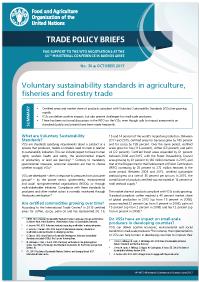
No. 30 Voluntary sustainability standards in agriculture, fisheries and forestry trade
11/07/2018
This brief discusses the application of voluntary sustainability standards in agriculture, fisheries and forestry trade.
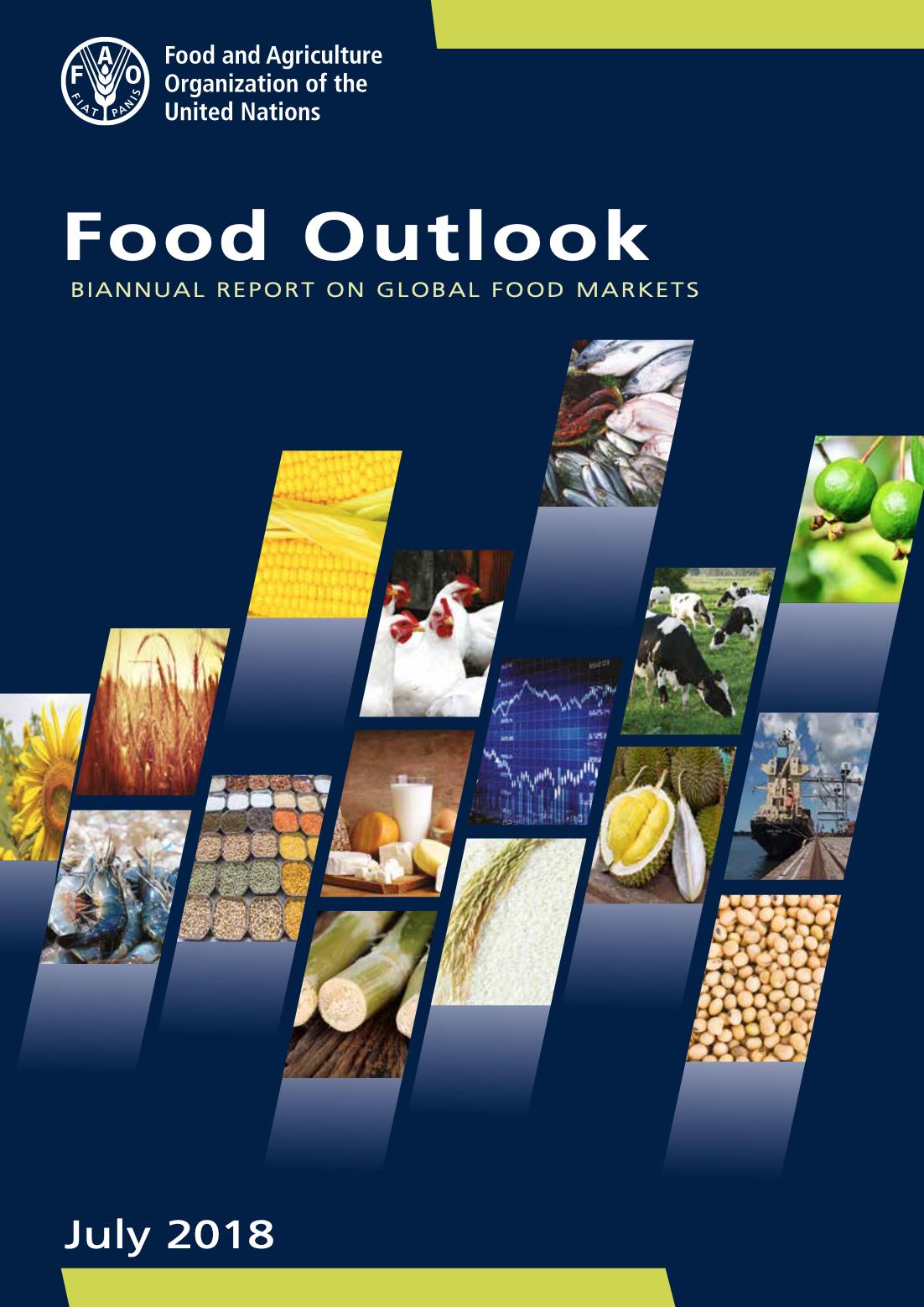
Food Outlook - July 2018
10/07/2018
Food Outlook is published by the Trade and Markets Division of FAO under Global Information and Early Warning System (GIEWS). It is a biannual publication focusing on developments affecting global food and feed markets. Each report provides comprehensive assessments and short term forecasts for production, utilization, trade, stocks and prices on a commodity by commodity basis and includes feature articles on topical issues. Food Outlook maintains a close synergy with another major GIEWS publication, Crop Prospects and Food Situation, especially with regard to the coverage of cereals. Food Outlook is available in English. The summary section is also available in Arabic, Chinese, French, Russian and Spanish.
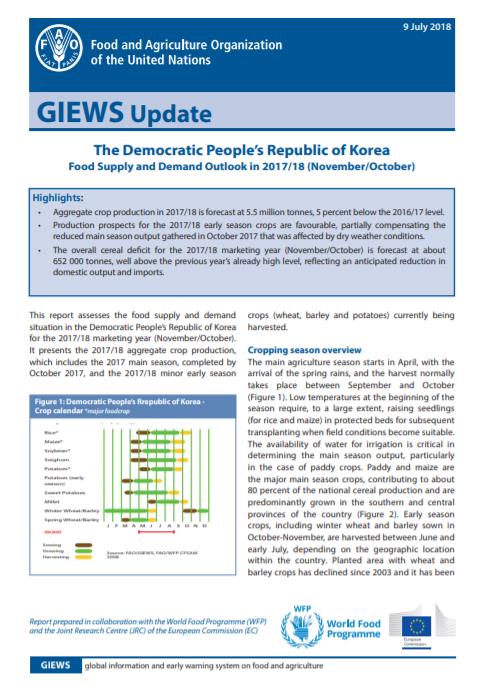
GIEWS Update - The Democratic People’s Republic of Korea, 9 July 2018
09/07/2018
Aggregate crop production in 2017/18 is forecast at 5.5 million tonnes, 5 percent below the 2016/17 level. Production prospects for the 2017/18 early season crops are favourable, partially compensating the reduced main season output gathered in October 2017 that was affected by dry weather conditions. The overall cereal deficit for the 2017/18 marketing year (November/October) is forecast at about 652 000 tonnes, well above the previous year’s already high level, reflecting an anticipated reduction in domestic output and imports.
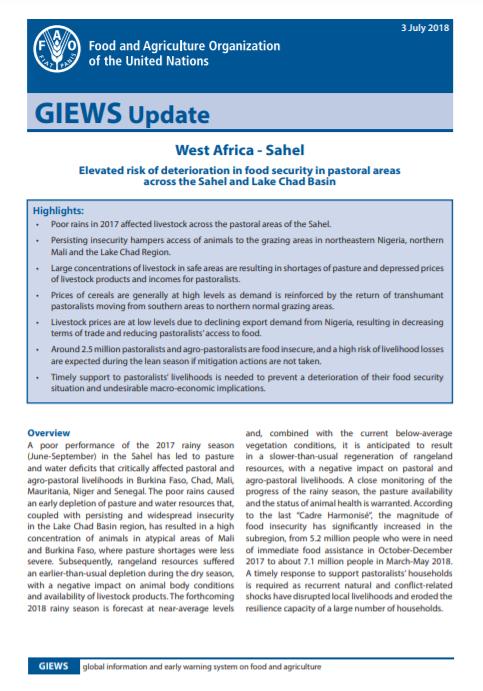
GIEWS Update - West Africa - Sahel, 3 July 2018
03/07/2018
Poor rains in 2017 affected livestock across the pastoral areas of the Sahel. Persisting insecurity hampers access of animals to the grazing areas in northeastern Nigeria, northern Mali and the Lake Chad Region. Large concentrations of livestock in safe areas are resulting in shortages of pasture and depressed prices of livestock products and incomes for pastoralists. Prices of cereals are generally at high levels as demand is reinforced by the return of transhumant pastoralists moving from southern areas to northern normal grazing areas. Livestock prices are at low levels due to declining export demand from Nigeria, resulting in decreasing terms of trade and reducing pastoralists’ access to food. Around 2.5 million pastoralists and agro-pastoralists are food insecure, and a high risk of livelihood losses are expected during the lean season if mitigation actions are not taken. Timely support to pastoralists’ livelihoods is needed to prevent a deterioration of their food security situation and undesirable macro-economic implications.
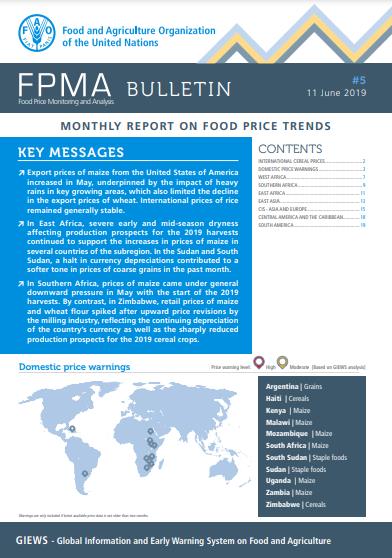
Food Price Monitoring and Analysis (FPMA) Bulletin #5, 11 June 2018
11/06/2018
Export prices of maize from the United States of America increased in May, underpinned by the impact of heavy rains in key growing areas, which also limited the decline in the export prices of wheat. International prices of rice remained generally stable. In East Africa, severe early and mid-season dryness affecting production prospects for the 2019 harvests continued to support the increases in prices of maize in several countries of the subregion. In the Sudan and South Sudan, a halt in currency depreciations contributed to a softer tone in prices of coarse grains in the past month. In Southern Africa, prices of maize came under general downward pressure in May with the start of the 2019 harvests. By contrast, in Zimbabwe, retail prices of maize and wheat flour spiked after upward price revisions by the milling industry, reflecting the continuing depreciation of the country’s currency as well as the sharply reduced production prospects for the 2019 cereal crops.

Dairy Market Review - October 2018
11/06/2018
World milk output is forecast to reach nearly 828 million tonnes in 2018, up 2.1 percent from 2017. This year, milk outputs are anticipated to increase in all major regions, with the largest increase is anticipated in Asia, followed by Europe, North America, and South America. Africa, Oceania and Central America are anticipated to recover from downturns experienced in 2017. In 2018, World dairy exports are forecast to reach 75 million tonnes, up 2.7 percent from the revised export figures for 2017. In 2018, much of the expanded global exports is expected to originate in the Americas and Oceania; stable in Europe and Africa; but to decline in Asia. The FAO Dairy Prices Index averaged 191.5 in September 2018, 6.4 percent higher than the level in January this year. At this level, the index is 14.6 percent below the corresponding month last year, and 30.5 percent below that of the peak it reached in February 2014.
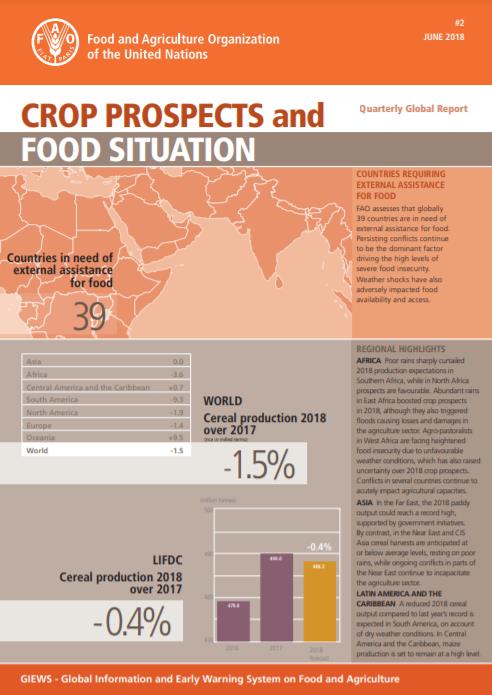
Crop Prospects and Food Situation - Quarterly Global Report, No. 2, June 2018
07/06/2018
Countries requiring external assistance for food: FAO assesses that globally 39 countries are in need of external assistance for food. Persisting conflicts continue to be the dominant factor driving the high levels of severe food insecurity. Weather shocks have also adversely impacted food availability and access.

Food Price Monitoring and Analysis (FPMA) Bulletin #4, 10 May 2018
10/05/2018
International prices of wheat and maize in April were generally higher, supported by weather concerns in key producing countries and brisk trade. International prices of rice increased in response to renewed import demand in Asia. In East Africa, in the Sudan, prices of staple foods, millet, sorghum and wheat, remained firm or increased in April and were at record or near-record highs, underpinned by a weak currency, the removal of wheat subsidies and increased transport costs. In Central America, prices of white maize increased sharply in March and April and reached levels well above those a year earlier in most countries of the subregion. Seasonal upward pressure was supported by higher purchasing prices from the milling industry, trends in the international market and increased fuel costs. In South America, prices of yellow maize and wheat continued to increase in Argentina, underpinned by strong demand and forecasts of lower crops this year. Prices of maize rose sharply also in Brazil, due to large exports and expectations of a decline in the 2018 harvests; those of wheat increased following the sharply reduced production last year and costlier imports.
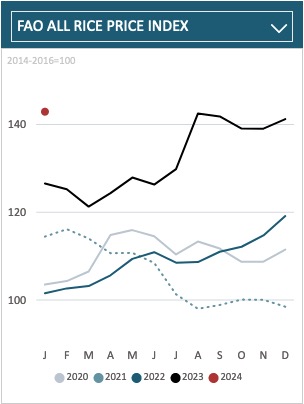
FAO Rice Market Monitor - April 2018
27/04/2018
The April 2018 issue of the FAO Rice Market Monitor (RMM) provides an analysis and forecasts of world rice production, utilization, and global rice inventories in 2017/2018 and 2018/19 season. It also covers the outlook of world trade in rice in calendar year 2018, as well as a review of international rice prices during the first quarter of 2018.
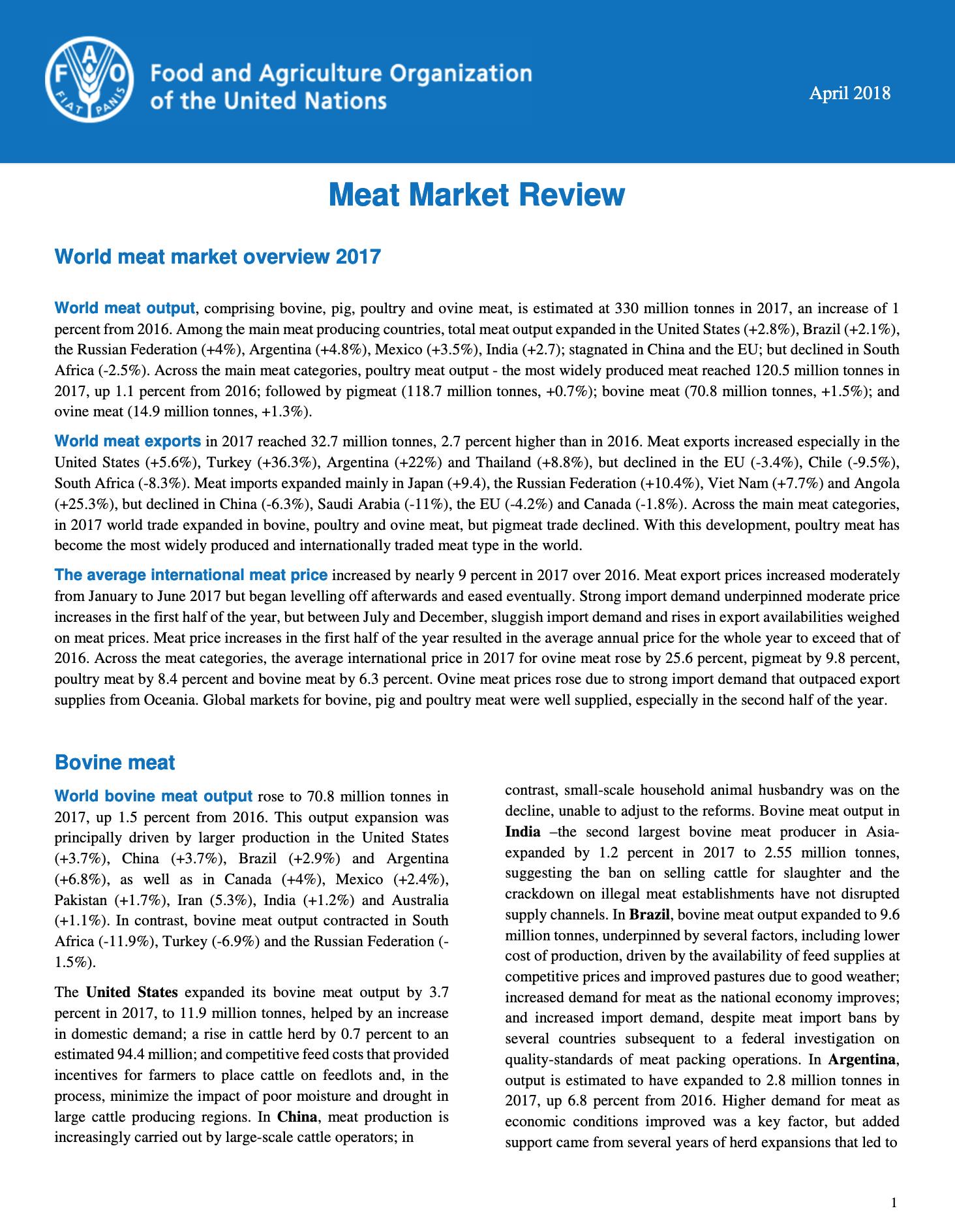
Meat Market Review: April 2018
25/04/2018
World meat output, comprising bovine, pig, poultry and ovine meat, is estimated at 330 million tonnes in 2017, an increase of 1 percent from 2016. Among the main meat producing countries, total meat output expanded in the United States (+2.8%), Brazil (+2.1%), the Russian Federation (+4%), Argentina (+4.8%), Mexico (+3.5%), India (+2.7); stagnated in China and the EU; but declined in South Africa (-2.5%). Across the main meat categories, poultry meat output - the most widely produced meat reached 120.5 million tonnes in 2017, up 1.1 percent from 2016; followed by pig meat (118.7 million tonnes, +0.7%); bovine meat (70.8 million tonnes, +1.5%); and ovine meat (14.9 million tonnes, +1.3%). World meat exports in 2017 reached 32.7 million tonnes, 2.7 percent higher than in 2016. Meat exports increased especially in the United States (+5.6%), Turkey (+36.3%), Argentina (+22%) and Thailand (+8.8%), but declined in the EU (-3.4%), Chile (-9.5%), South Africa (-8.3%). Meat imports expanded mainly in Japan (+9.4), the Russian Federation (+10.4%), Viet Nam (+7.7%) and Angola (+25.3%), but declined in China (-6.3%), Saudi Arabia (-11%), the EU (-4.2%) and Canada (-1.8%). Across the main meat categories, in 2017 world trade expanded in bovine, poultry and ovine meat, but pig meat trade declined. With this development, poultry meat has become the most widely produced and internationally traded meat type in the world. The average international meat price increased by nearly 9 percent in 2017 over 2016. Meat export prices increased moderately from January to June 2017 but began levelling off afterwards and eased eventually. Strong import demand underpinned moderate price increases in the first half of the year, but between July and December, sluggish import demand and rises in export availabilities weighed on meat prices. Meat price increases in the first half of the year resulted in the average annual price for the whole year to exceed that of 2016. Across the meat categories, the average international price in 2017 for ovine meat rose by 25.6 percent, pig meat by 9.8 percent, poultry meat by 8.4 percent and bovine meat by 6.3 percent. Ovine meat prices rose due to strong import demand that outpaced export supplies from Oceania. Global markets for bovine, pig and poultry meat were well supplied, especially in the second half of the year
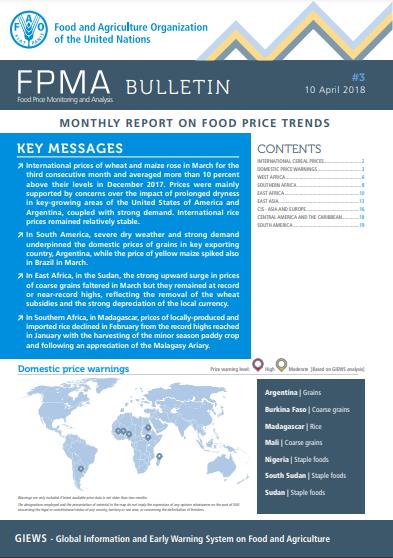
Food Price Monitoring and Analysis (FPMA) Bulletin #3, 10 April 2018
10/04/2018
International prices of wheat and maize rose in March for the third consecutive month and averaged more than 10 percent above their levels in December 2017. Prices were mainly supported by concerns over the impact of prolonged dryness in key-growing areas of the United States of America and Argentina, coupled with strong demand. International rice prices remained relatively stable. In South America, severe dry weather and strong demand underpinned the domestic prices of grains in key exporting country, Argentina, while the price of yellow maize spiked also in Brazil in March. In East Africa, in the Sudan, the strong upward surge in prices of coarse grains faltered in March but they remained at record or near-record highs, reflecting the removal of the wheat subsidies and the strong depreciation of the local currency. In Southern Africa, in Madagascar, prices of locally-produced and imported rice declined in February from the record highs reached in January with the harvesting of the minor season paddy crop and following an appreciation of the Malagasy Ariary.
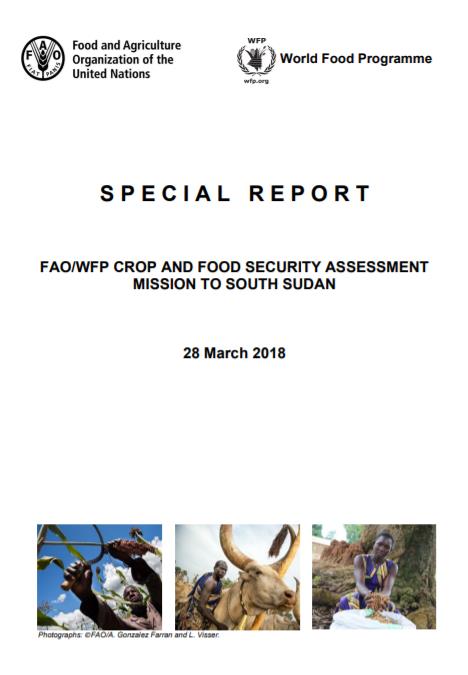
Special Report - FAO/WFP Crop and Food Security Assessment Mission to South Sudan - 28 March 2018
28/03/2018
An FAO/WFP Crop and Food Security Assessment Mission (CFSAM) visited South Sudan from 4 to 14 December 2017 to estimate the cereal production during 2017 and assess the overall food security situation. The CFSAM reviewed the findings of several Crop Assessment Missions conducted at planting and harvest time in the different agro-ecological zones of the country from May to December 2017. As during 2014, 2015 and 2016, all Assessment Missions were carried out by a Task Force Team that comprised staff from the Ministry of Agriculture and Food Security (MAFS), the National Bureau of Statistics (NBS) and FAO. Task Force Team members have been trained during the past years to conduct rapid assessments using established protocols and techniques, such as driving and walking transects, scoring standing crops according to yield, and livestock according to body condition, perform key informant interviews and farmer case studies. In addition, supported by the FAO/AFIS Project, 39 County Crop Monitoring Committees (CCMCs) have been formed in 2016 and 2017, with a view to extending the responsibility of collecting more objective data at local level.
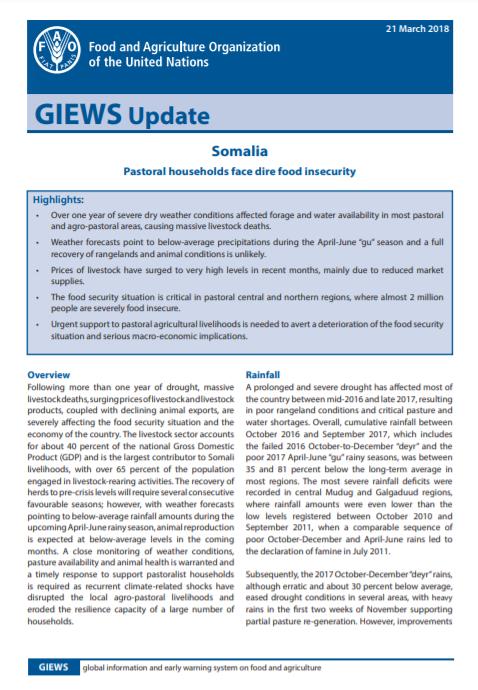
GIEWS Update - Somalia, 21 March 2018
21/03/2018
Over one year of severe dry weather conditions affected forage and water availability in most pastoral and agro-pastoral areas, causing massive livestock deaths. Weather forecasts point to below-average precipitations during the April-June “gu” season and a full recovery of rangelands and animal conditions is unlikely. Prices of livestock have surged to very high levels in recent months, mainly due to reduced market supplies. The food security situation is critical in pastoral central and northern regions, where almost 2 million people are severely food insecure. Urgent support to pastoral agricultural livelihoods is needed to avert a deterioration of the food security situation and serious macro-economic implications.
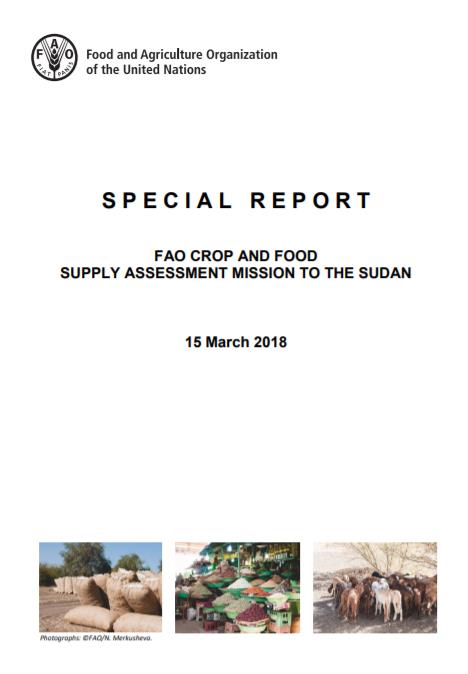
Special Report - FAO Crop and Food Supply Assessment Mission to The Sudan - 15 March 2018
15/03/2018
Between 17 November and 15 December 2017, assisted by the Food and Agriculture Organization of the United Nations (FAO), the Ministry of Agriculture and Forestry (MoAF) carried out its annual Assessment Mission to determine crop production and the food supply situation throughout the 18 states of the Sudan. The Mission consisted of six core teams comprising members from the MoAF, the Food Security Technical Secretariat (FSTS) of the MoAF, the Ministry of Animal Resources (MoAR), the Humanitarian Aid Commission (HAC), the Strategic Reserve Corporation (SRC), FAO, FEWS NET, WFP and USAID. Prior to departure, the team members attended a preliminary Training Workshop in Khartoum to standardize the methodology to be used in the field and to prepare the teams for the field visits.
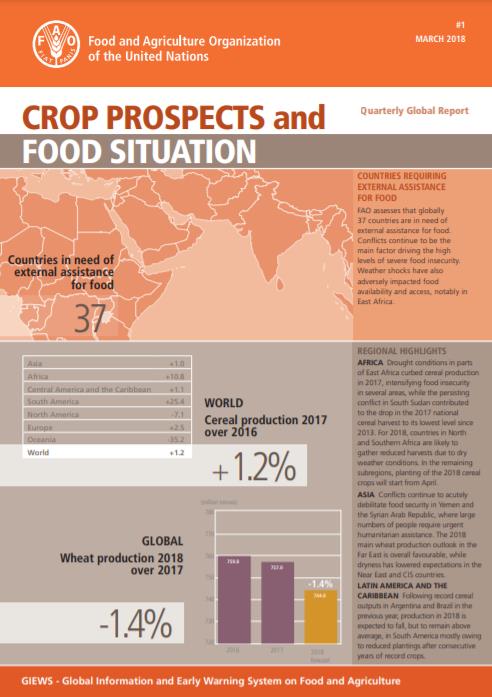
Crop Prospects and Food Situation - Quarterly Global Report, No. 1, March 2018
05/03/2018
FAO assesses that globally 37 countries are in need of external assistance for food. Conflicts continue to be the main factor driving the high levels of severe food insecurity. Weather shocks have also adversely impacted food availability and access, notably in East Africa.
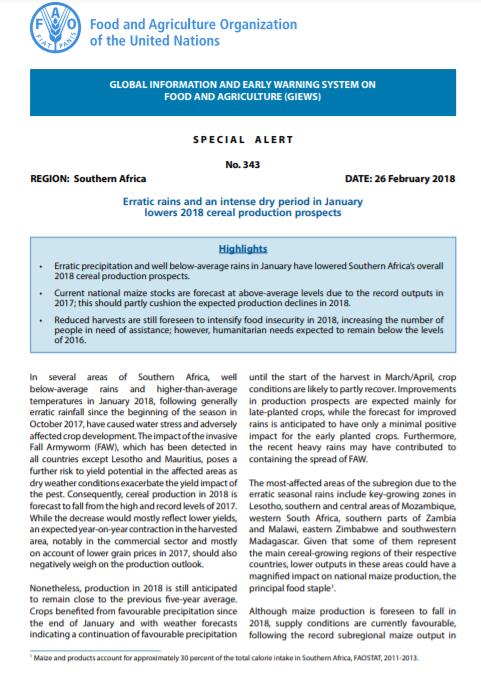
GIEWS Special Alert No. 343 - Southern Africa, 26 February 2018
26/02/2018
Erratic precipitation and well below-average rains in January have lowered Southern Africa’s overall 2018 cereal production prospects. Current national maize stocks are forecast at above-average levels due to the record outputs in 2017; this should partly cushion the expected production declines in 2018. Reduced harvests are still foreseen to intensify food insecurity in 2018, increasing the number of people in need of assistance; however, humanitarian needs expected to remain below the levels of 2016.
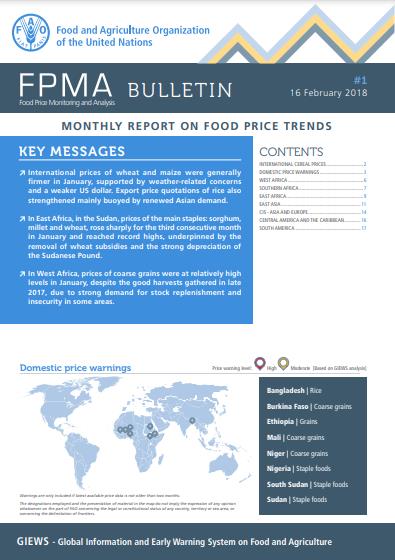
Food Price Monitoring and Analysis (FPMA) Bulletin #1, 13 February 2018
13/02/2018
International prices of wheat and maize were generally firmer in January, supported by weather-related concerns and a weaker US dollar. Export price quotations of rice also strengthened mainly buoyed by renewed Asian demand. In East Africa, in the Sudan, prices of the main staples: sorghum, millet and wheat, rose sharply for the third consecutive month in January and reached record highs, underpinned by the removal of wheat subsidies and the strong depreciation of the Sudanese Pound. In West Africa, prices of coarse grains were at relatively high levels in January, despite the good harvests gathered in late 2017, due to strong demand for stock replenishment and insecurity in some areas.
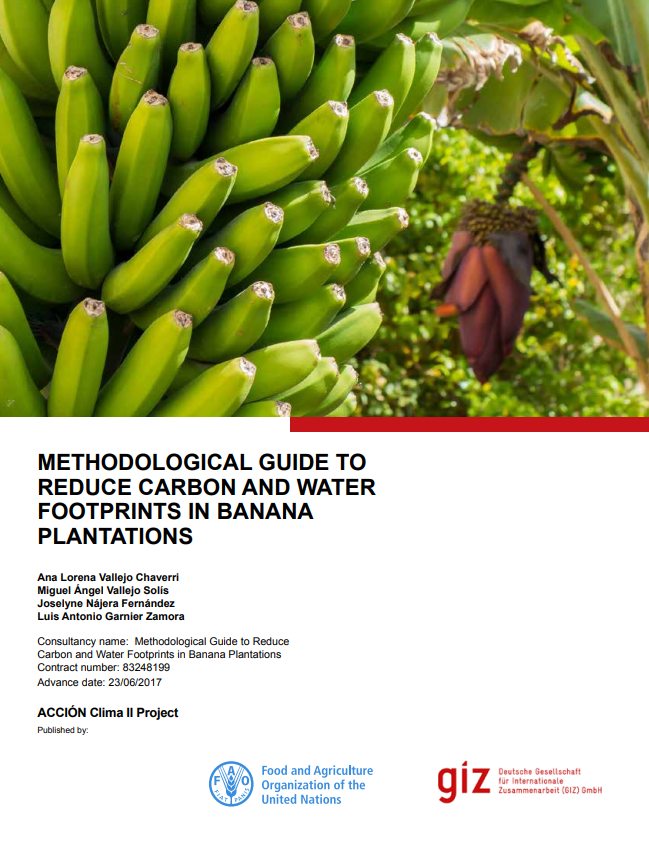
Methodological guide to reduce carbon and water footprints in banana plantations
12/02/2018
The World Banana Forum (WBF) publication developed a methodological guide to reduce water and carbon footprints in banana plantations worldwide. Members of the Working Group (WG) on Sustainable Production Systems and Environmental Impact acknowledged the contribution of banana production in the total global GHG emissions and the consumption of freshwater in the economic activity, both stressed in the 2015 COP21, having the agricultural sector a high mitigation potential.
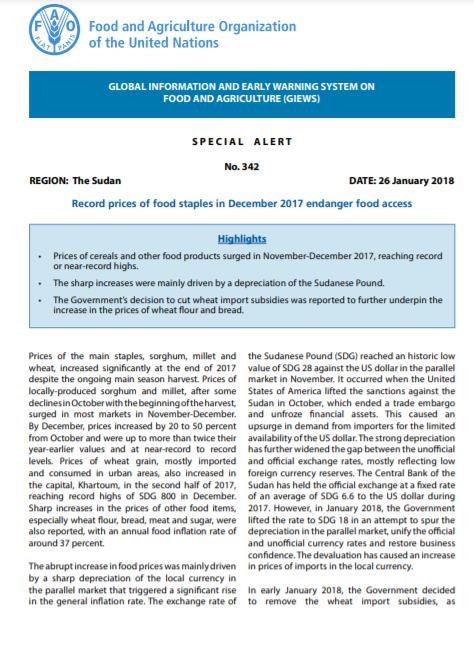
GIEWS Special Alert No. 342 - The Sudan, 26 January 2018
26/01/2018
In the Sudan the prices of the main staples, sorghum, millet and wheat increased significantly at the end of 2017, mainly driven by a sharp depreciation of the local currency and the Govenrnment's decision to remove the subsidies on wheat imports.
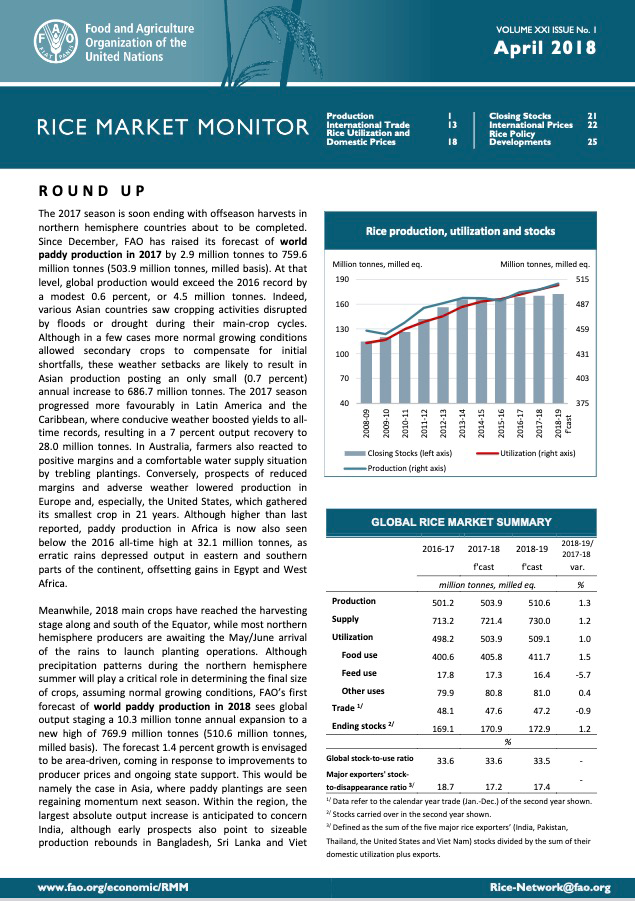
FAO Rice Market Monitor
01/01/2018
The FAO Rice Market Monitor (RMM) is a quarterly publication, providing an analysis of the most recent developments in the global rice market.
